How To Decode The VIN
The car’s Vehicle Identification Number (VIN) is an identifying code for that specific vehicle. VIN’s are unique to each vehicle, much like fingerprints are to people; no two are alike.
Each VIN is comprised of 17 digits, using both numbers and capital letters. Each character represents a unique feature on the car, such as the manufacturer, body style, model year, and engine type.
Vehicles manufactured before 1980 VIN’s came in varying lengths from 11 to 17 characters long, then became standardized in the United States in 1981.
Car manufacturers use VIN’s to track car ownership, post vehicle recalls, and monitor their warranty.
Insurance companies use the VIN to track vehicle theft or insurance write-offs.
As a service advisor, you will need to use the VIN to look up the following:
- Lookup vehicle history
- Track service activity
- Factory in-warranty date
- Extended warranty
- Maintenance contracts
- Open recalls
- Warranty cancelations
All VIN’s Do Not Read Equally
While today’s VIN’s are 17 characters long, they do not decode in the same way. It depends on the car manufacturer. Most of the information in a VIN is standardized, but where they place the information is not. The same goes for how many digits are needed before decoding the VIN. Individual characters represent a lookup code for some carmakers, while others use three digits to form their lookup code.
For example, Ford and General Motors use the 8th position in the VIN to display the engine type using just one digit. However, Honda uses three digits to display their engine code and is positioned in the 4th through 6th spot in the VIN. In contrast, Toyota uses VIN positions 4th through 8th to display their engine code.
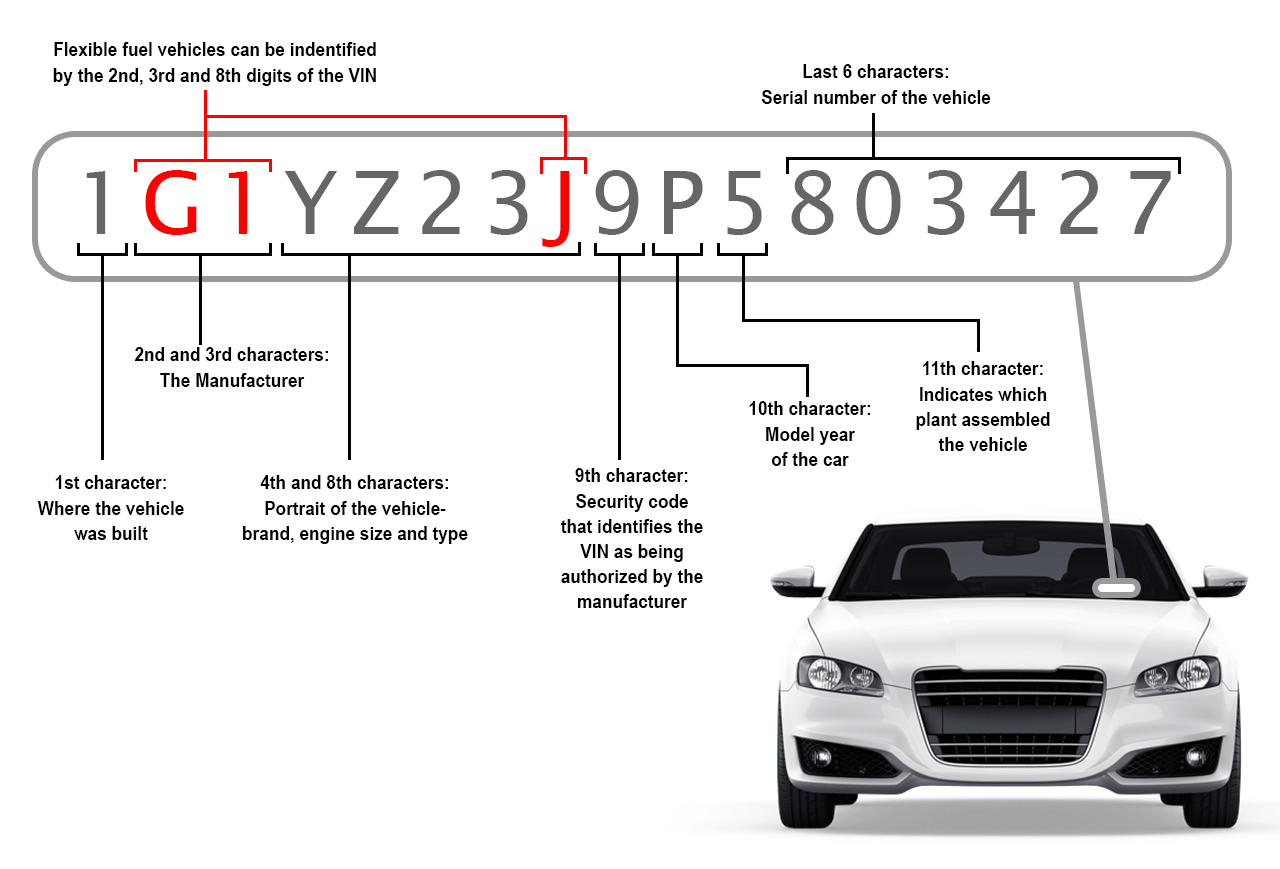
The VIN format information provided in this lesson is North American based. Always check with each manufacturer in the country you are in for accurate VIN decoding information.
Automotive shop management systems will automatically decode VIN’s. So, thankfully you don’t have to memorize VIN codes; make sure you recorded it correctly. The easiest thing to do is ask the customer for their vehicle’s ownership and hold it against the VIN located at the bottom of the dashboard to ensure they match. Alternatively, you can take a picture of the VIN and input it into the management system once back at your desk.
However, if you want to memorize VIN’s, the codes most relied on by service advisors are the model year (10th digit), engine code (4th to 6th or 8th digit), and the last 6 digits.
Locating The VIN
The most common place to find the VIN is on the dashboard. While standing outside of the vehicle, look at the windshield’s bottom corner on the driver’s side. You will see a metal plate with the VIN stamped on it.
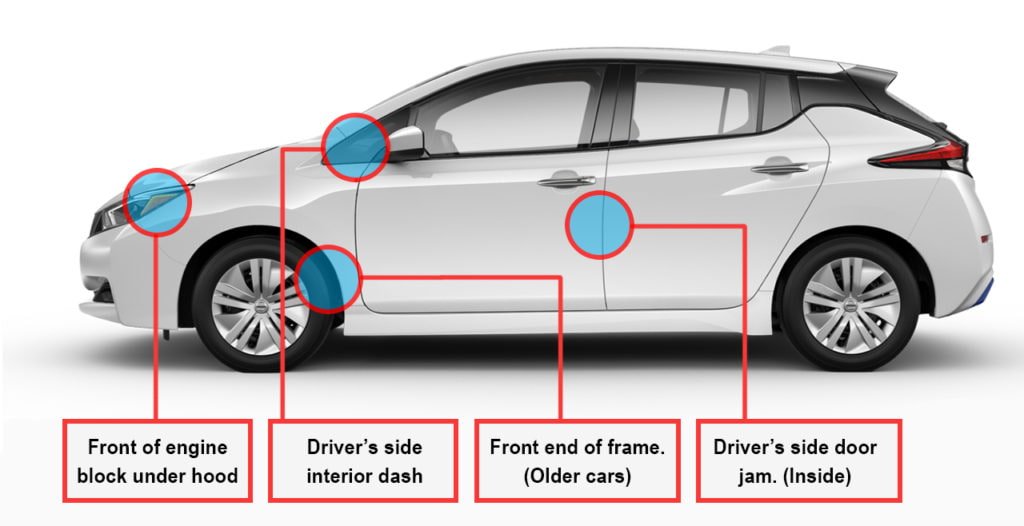
You can find additional VIN locations on:
- Inside driver’s side dashboard
- Side of the driver’s door
- Driver’s side post
- Front of the engine block
- Front of the car frame, near the washer fluid
- Rear-wheel well
- Underneath the spare tire
VIN’s are also programmed into electronic devices on newer cars and trucks for security reasons.
Components of VIN’s
VIN’s codes are divided into three components:
WMI = World manufacturer identifier
VDS = Vehicle descriptor section
VIS = Vehicle identifier section
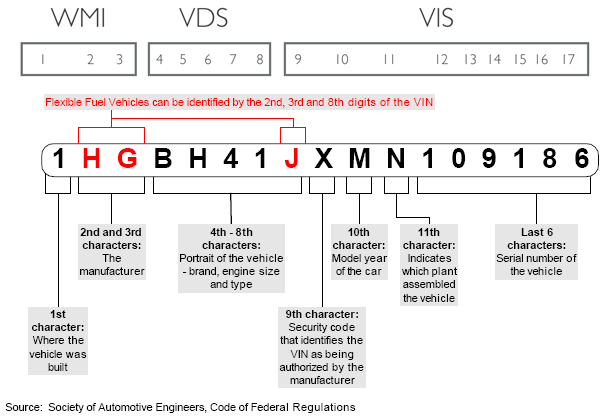
World Manufacturer Identifier Code (WMI)
Digits 1 through 3 tell you which country built the car and the manufacturer’s brand.
The first three digits are always combined and are called the World Manufacturer Identifier or WMI for short. The Society of Automotive Engineers created the WMI; they assigned unique WMI’s to each country and manufacturer.
The 1st digit of the VIN represents which country assembled the vehicle. For example, the United States is 1, 4, 5. Canada is 2, and Mexico is 3.
- 1 to 5 means made in North America
- 6 to 7 means made in New Zealand or Australia
- 8 to 9 is for South America
- A to H is Africa
- J to R (except O and Q) means made in Asia
- S to Z made in Europe
Next, the 2nd digit represents the manufacturer. For example, ‘G’ is for General Motors. Here are a few more examples:
- A is Audi
- B is BMW
- C is Chrysler
- D is Dodge
- F is Ford
- G is General Motors
- H is Honda
- J is Jeep
- L is Lincoln
- N is Nissan
- T is Toyota
The 3rd digit points out the manufacturing division or vehicle’s type when coupled with the first two digits. It can signify if it’s a car, SUV, truck. Alternatively, it could be a brand such as GMC, Chevrolet, or Cadillac.
For example, a VIN starting with ‘1GC’ means the 1 is the United States for the country of origin. The G means General Motors, and C is for Chevrolet Truck.
- 1 is Chevrolet
- 4 is Buick
- 6 is Cadillac
- C is Chevrolet Truck
- T is GMC
The Vehicle Descriptor Code (VDS)
Digits 4th through 8th contain the vehicle description information.
Carmakers use this section to describe the vehicle’s model line and trim package. These characters can be grouped together to form codes or used independently. It all depends on the car manufacturer’s preference and how detailed they wish to be.
The vehicle’s model type starting from the 4th to 8th character describes the following details:
- Engine type
- Transmission type
- Body style
- Trim level
- Restraint system (vehicles safety device)
- Gross vehicles weight rating (GVWR)
There are currently too many code combinations to list, so you must check each manufacturer’s lookup table. It’s easier to use the automotive shop’s computer system to decode VIN’s rather than spending the time looking them up individually. Their system is quicker and more precise too.
Check Digit Code
The 9th digit is called a “check digit” and acts as the vehicle’s security code.
The U.S. Department of Transportation developed it to detect fraudulent VIN’s, using a mathematical formula. It can either be a number or a letter generated by the manufacturer.
Vehicle Identification Section (VIS)
Digits 10 to 17 of the VIN references the VIS, which is short for the Vehicle Identifier Section.
The 10th and 11th characters represent the model year and assembly plant. Finally, the last six remaining characters are the car’s serial number.
Model Year Code
The 10th digit shows the model year.
- Vehicle model years 1981 to 2000 use letters B to Y
- Vehicle model years 2001 to 2009 use numbers 1 to 9
- Vehicle model years 2010 to 2030 use letters A to Y
If the 10th digit is an ‘M,’ the vehicle could be a 1991 or 2021 model year. Furthermore, if the 10th digit is a ‘1’, it could be a 2001 or 2031 model year.
Plant Code
The 11th digit is the manufacturer’s plant code. Vehicle manufacturers all have unique codes showing which manufacturing plant assembled the vehicle.
Sequential Number Code
Digits 12 through 17 number the vehicle gets as it rolls through the production line.
These numbers are always sequential and may start with a letter. One example is the first vehicle in a model line at the beginning of the year might start with 000001. Alternatively, they could start with a letter and end with numbers A00001. Letters not used in a VIN are I, O, and Q.
The sequential number code is often referred to as “the last six” or “the last eight” in the automotive industry. Service advisors use the last six to locate vehicles at the shop’s management system or the last eight in the manufacturer portal.
VIN Lookup Code Positions Of Different Manufacturers
As mentioned earlier, each manufacturer positions its lookup codes in different parts of the VIN. Here are four examples of this:
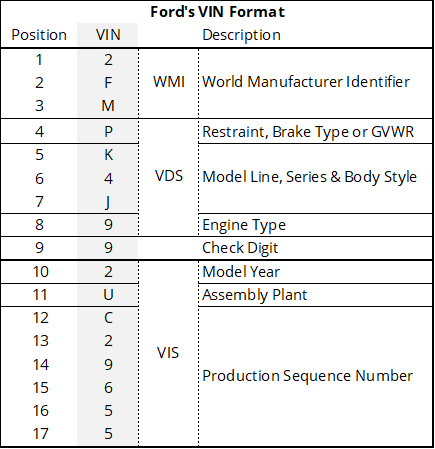
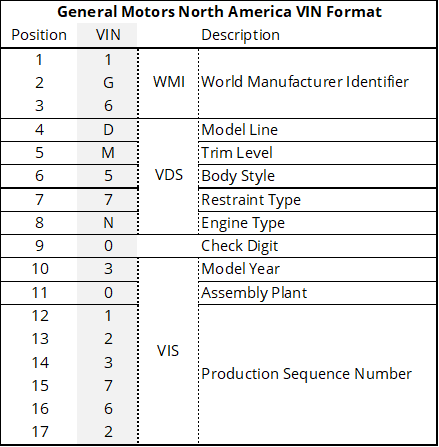
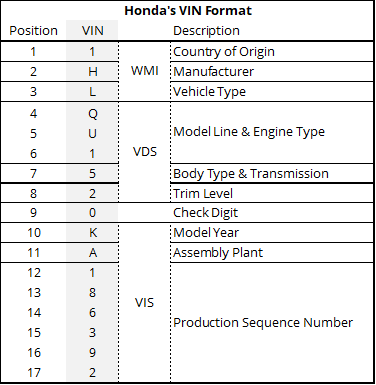
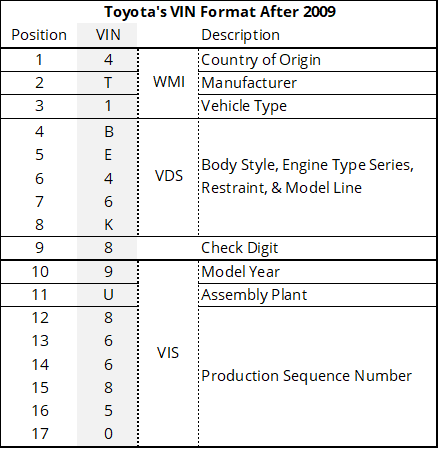
Sample VIN Decoded
Here’s a 2010 Honda Accord with the VIN decoded.
1HGCP2F3XAA000001
- 1st to 3rd digit = Manufacturer, Country of Origin & Vehicle Type: Honda of America – Passenger vehicle
- 4th to 6th digits = Model Line & Engine Type: Accord 4-Door, 2.4L L4 DOHC 16V, K24Z2, K24Z3
- 7th digit = Body & Transmission type: 4-Dr. Sedan, A/T
- 8th digit = Trim Level: LX 92/4 Dr.), LX-S (2 Dr.)
- 9th digit = Check Digit: X
- 10th digit = Model Year: 2010
- 11th digit = Assembly Plant: Marysville, Ohio, USA
- 12th to 17th digit = Sequential Number: 000001
Using a 2007 Chevrolet Impala with a VIN of 2G1WB58N2XA900001 as an example.
- 1st to 3rd digit = Manufacturer & Country of Origin: Chevrolet & Canada
- 4th to 5th digit = Model Line, & Trim Level: Impala LS
- 6th digit = Body Style: Four-Door Sedan
- 7th digit = Restraint Type: Occupant Sensor
- 8th digit = Engine Type: LA3 – 3.2L – V6 – MFI
- 9th digit = Check Digit: X
- 10th digit = Model Year: 2007
- 11th digit = Assembly Plant: Oshawa, Ontario, Canada
- 12th to 17th digit = Sequential Number: 000001
Now you see the difference between each manufacturer’s VIN formats. Again, don’t worry about memorizing VIN’s, the software program at your shop will decode them for you.
Shop Tip:
- Today’s software system used in shops will automatically decode VIN’s
- To keep track of cars, most shops use the last six or eight digits of the VIN
- Always double-check the VIN in the shop’s system against the customer’s car


